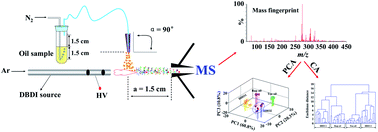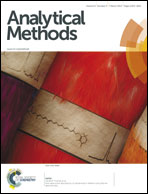Coupling neutral desorption sampling to dielectric barrier discharge ionization mass spectrometry for direct oil analysis
Abstract
Rapid analysis of viscous oil samples is of great interest in food science and the food industry. Herein, neutral desorption sampling in conjunction with dielectric barrier discharge ionization mass spectrometry (ND-DBDI-MS) has been established for the fast and accurate identification of various hogwash oil (HHO) and edible oil samples under ambient conditions. Mass spectra in the negative ion detection mode were recorded in the mass range of m/z 50–500 Da, and characteristic substances responsible for the classification were identified using MS/MS experiments. Particularly, free fatty acids (e.g., oleic acid, linoleic acid, palmitic acid, etc.), typical representatives of oil quality, were successfully measured and used as decisive markers to differentiate HHO from qualified edible oil samples with the help of principal component analysis (PCA). Methodological reproducibility was characterized in terms of statistical method such as cluster analysis (CA). The experimental results show that ND-DBDI-MS is an important tool for the rapid analysis of highly complex viscous samples such as oil samples, with potential applications in food safety analysis.


 Please wait while we load your content...
Please wait while we load your content...